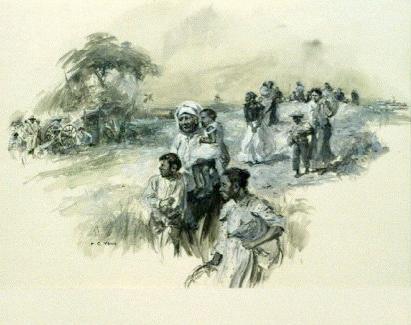
Cuban History: Independence Struggle (1868-98)

Figure 1.--This is a depictionnof civilins at Jiguani during the Cuban War for Indepenence. Jiguaní is a town and municipality in the Granma Province of western Cuba. It is located 25 kilometres east of Bayamo, the provincial capital. The name 'Jiguaní' is of Native America (Taíno) origin and means 'height of the river. Jiguaní was where the 1895 independence war was launched an a rebel strnghold.
Illustator F.C. (Frederick Coffay) Yohn (1875-1933).
|
|
Most of Spain's American colonies achieved independence during or after the Napoleonic Wars of the early 19th century. Spain held on to Cuba and and Puerto Rico after defeats in South and Central America. Cubans began their struggle for independence at mid-century. The first major armed action was the War of the Ten Years (1868-78). A poorly equipped army of 8,000 Cubans fought a valiant struggle against aell-armed Spanish army which suffered some 80,000 casualties. The revolutionaries which failed to fight a centrally organized campaign finally had to give up with the Pact of the Trench, although General Antonio Maceo issued the protest of Baraguá. A second insurrection was organized by Jose Martí (1895). The Army of Liberation was better organized than in 1868 and was commanded by General Maximum Gómez. The Army of Liberation eventually fielded about 50,000 men, but only about half were armed. They were organized into six Army Corps with 14 divisions, 34 brigades and 84 regiments, of which 34 were of cavalry and 50 were infantry and other forces. The organizational structure structure reflected the territorial distribution rather than the number of troops. The Spanish commited an army of about 250,000 men. The still the Spanish held on. In the campaign they suffered about 71,000 casualties and the war proved a major drain on the Spanish economy. The Spanish Army was able to hold on to the major cities, but most of the countryside was in rebel hands. The Cubans did not have the military force need to take the cities and the Spanish did not have an adequate force to pursue the rebels into the countryside. Thus an uneasy deadlock developed. The American press began covering the conflict, siding with the rebels. The fighting occured before photo-lithogrphy had been perfected, but such was the interest in the War that several illustrators provided ofren sensational illustrations. The American Yellow Press era peaked at the very time that the Cubans lunched the 1895 revolution. nd the conflict providdfoder for both Hearst and Pulitzer. This would be a factor in eventual American intervention.
CIH

Navigate the Children in History Website:
Return to the Main Cuban history page]
[Return to the Main Caribbean history page]
[Return to the Main Latin American history page]
[Return to the Main Latin American page]
[Return to the Main countries page]
[About Us]
[Introduction]
[Biographies]
[Chronology]
[Climatology]
[Clothing]
[Disease and Health]
[Economics]
[Freedom]
[Geography]
[History]
[Human Nature]
[Law]
[Nationalism]
[Presidents]
[Religion]
[Royalty]
[Science]
[Social Class]
[Bibliographies]
[Contributions]
[FAQs]
[Glossaries]
[Images]
[Links]
[Registration]
[Tools]
[Children in History Home]
Created: 7:26 PM 6/25/2013
Last updated: 11:57 PM 1/8/2016



